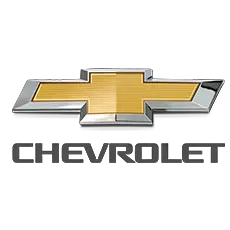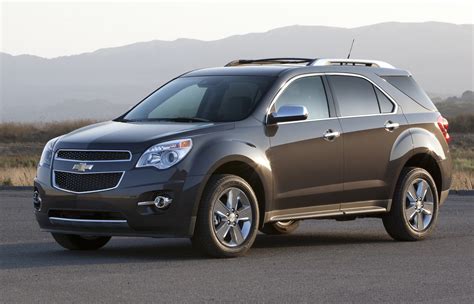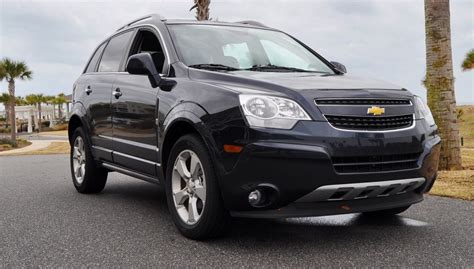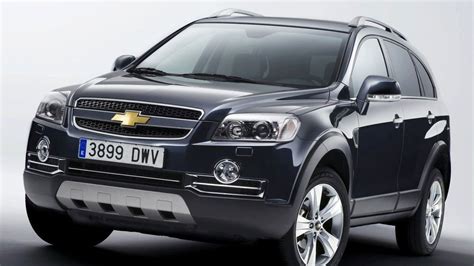Chevrolet Captiva sport problems

The Chevrolet Captiva is a compact crossover SUV marketed by General Motors. The first generation was developed by GM Korea, based on the GM Theta platform and derived from the S3X concept car revealed in 2004. Released in 2006, it was sold internationally as Chevrolet Captiva, in Australia and New Zealand as Holden Captiva and in South Korea as Daewoo Winstorm until 2011, when the international name was adopted. The vehicle shares much its underpinnings with the similarly-styled Opel/Vauxhall Antara / second-generation Saturn Vue, with the Captiva offering optional third-row seating.
In 2018, Chevrolet ended production of the first-generation Captiva and began replacing it worldwide with the Equinox. The second-generation Captiva, which is a rebadged Baojun 530 produced in China by SAIC-GM-Wuling, was introduced in Colombia in November 2018 and Thailand in March 2019. The second-generation model is also offered in many Latin American markets, including Mexico since 2021.
First generation (C100, C140; 2006)
The Captiva is a front-wheel or all-wheel drive SUV; the engines were supplied by Holden in Australia, the Family II naturally aspirated four-cylinder petrol or the Alloytec Holden V6 built in Australia, and later a 2.0-L turbo-diesel supplied by VM Motori in South Korea.
Designated C100 by Daewoo and CG in Holden's terminology, the Captiva was launched in 2006. Styling of the Captiva was inspired by the 2004 Chevrolet S3X concept car. The S3X concept was developed by GM Daewoo's design center in Bupyeong-gu, Incheon and is based on the GM Theta platform. It premiered at 2004 Paris Motor Show. Another concept car, by Daewoo, the Chevrolet T2X premiered at the 2005 Seoul Motor Show with its design was based on the S3X, using a shortened platform. The T2X is referred to as a sport utility coupe, accounting for its rear hinged doors, lack of conventional B-pillars, and shortened wheelbase—features that were first revealed on the "Daewoo Oto" (later renamed "Daewoo Scope") concept at the 2002 Seoul Motor Show. Production was slated for late 2006, but as of 2009 no further announcement has been made.
For the Captiva, the production version of the S3X, both five- or seven-seat configurations are available. Standard safety features include: antilock brakes, electronic stability control (ESC), front seatbelt pretensioners and force limiters, and driver and front-passenger airbags. Side-curtain airbags are standard on higher luxury-level variants in some markets. In crash safety tests conducted by Euro NCAP, the Captiva was given a four out of five stars crash rating. The results from the test were helped by the use of high-strength steel used in the body shell which was designed to spread crash forces over distinct load channels, therefore ensuring the safety of the occupants within the safety cell. The vehicle's optional active all-wheel drive system is fully incorporated with the ESC and antilock braking systems, consequently improving car handling and control. When the vehicle detects a loss of traction, the all-wheel drive mode is activated automatically. In ordinary driving situations, only the vehicle's front wheels are used.

Social links
Chevrolet Captiva sport model years



Common Chevrolet Captiva sport problems
Based on the information provided in the sources, here are some common problems with the Chevrolet Captiva Sport cars based on complaints from owners:
- Battery Issues:
- Complaints suggest that the battery in Chevrolet Captiva cars tends to die more frequently and sooner than expected. There are also reports of the battery getting too hot, leading to potential failures.
- Alternator Failure:
- Alternator failure is a common issue around 60,000 miles in Chevrolet Captiva cars, causing electrical system problems and potentially leading to battery issues.
- Transmission Problems:
- Total transmission failure has been reported around 73,000 miles in some Chevrolet Captiva cars, indicating significant issues with the transmission system.
- Engine Troubles:
- Owners have reported various engine problems in Chevrolet Captiva cars, including excessive oil consumption, timing chain failure, rough engine running, and faulty camshaft actuator sensor.
- Key Stuck in Ignition:
- A prevalent complaint is the key getting stuck in the ignition, particularly between 60,000 and 70,000 miles, causing inconvenience and potential safety concerns.
- Electrical System Concerns:
- Issues with the instrument panel blacking out, drive train jerking, Stabilitrak engaging randomly, and power windows malfunctioning have been reported, indicating electrical system challenges.
- Other Miscellaneous Problems:
- Additional complaints include reverse gear issues, loss of power while driving forward, and overheating after specific repairs or recalls.
These problems highlight a range of issues that Chevrolet Captiva Sport owners have faced, encompassing battery, alternator, transmission, engine, key ignition, electrical system, and other miscellaneous concerns. Addressing these issues promptly and with proper maintenance can help mitigate potential risks and ensure the longevity of the vehicle.

Is Chevy Captiva Sport reliable?
Chevrolet Captiva Sport Reliability Rating Breakdown. The Chevrolet Captiva Sport Reliability Rating is 3.5 out of 5.0, which ranks it 19th out of 26 for compact SUVs. The average annual repair cost is $585 which means it has average ownership costs.
How many miles does a Chevy Captiva Sport last?
What is Chevrolet Captiva lifespan? The estimated lifespan of a Chevrolet Captiva is 142,000mi, before reaching the life expectancy upper limit. Fuel type is a major factor when looking into a vehicles lifespan/life expectancy.
What are the disadvantages of the Chevy Captiva?
Engine problems are numerous for the Captiva. There are issues reported for excessive oil consumption, timing chain failure, engine running rough, and a faulty camshaft actuator sensor. Another very common complaint that seems to happen primarily between 60,000 and 70,000 miles is the key getting stuck in the ignition.
Is there a recall on Chevrolet Captiva Sport?
GENERAL MOTORS (GM) IS RECALLING CERTAIN MODEL YEAR 2011-2012 CHEVROLET CAPTIVA VEHICLES MANUFACTURED FROM OCTOBER 2, 2009, THROUGH APRIL 21, 2011. DRIVING THE VEHICLE WITH THE TRANSMISSION IN MANUAL MODE AND IN FIRST GEAR CAUSES THE ENGINE AND POWER STEERING PUMP TO OPERATE AT HIGHER SPEED THAN IS TYPICAL.
Recalls Chevrolet Captiva sport
The National Highway Traffic Safety Administration (NHTSA) has issued 2 recalls for different components of the Chevrolet Captiva sport.You can explore the year of the Volkswagen Jetta you are interested in by selecting it from the list.
- Model: Chevrolet Captiva sport 2012
- Report Received Date: 2012-06-28
- Manufacturer: GENERAL MOTORS LLC
- Components: PARKING BRAKE
- Summary: GENERAL MOTORS LLC (GM) IS RECALLING CERTAIN MODEL YEAR 2012 CHEVROLET CAPTIVA SPORT PASSENGER VEHICLES MANUFACTURED FROM APRIL 26, 2012, THROUGH MAY 17, 2012. THESE VEHICLES FAIL TO CONFORM TO THE PARK BRAKE PERFORMANCE REQUIREMENTS FEDERAL MOTOR VEHICLE SAFETY STANDARD NO. 135, "LIGHT VEHICLE BRAKE SYSTEMS." THE PARK BRAKE CABLE MAY NOT BE FULLY SEATED IN ITS CONNECTOR AND MAY SEPARATE FROM THE CONNECTOR. IF THIS OCCURS, THE PARK BRAKE WILL BECOME INOPERATIVE AND WILL NOT HOLD THE VEHICLE.
- Consequence: IF THE VEHICLE IS ON AN UNEVEN SURFACE, THIS COULD RESULT IN UNINTENDED VEHICLE MOVEMENT AND A CRASH.
- Remedy: GM WILL NOTIFY OWNERS, AND DEALERS WILL INSPECT AND ENSURE THAT THE PARK BRAKE CABLES ARE CONNECTED AND SECURE FREE OF CHARGE. THE SAFETY RECALL BEGAN ON JULY 27, 2012. OWNERS MAY CONTACT THE CHEVROLET OWNER CENTER AT 1-866-694-6546.
- Model: Chevrolet Captiva sport 2012
- Report Received Date: 2011-12-19
- Manufacturer: GENERAL MOTORS LLC
- Components: STEERING:HYDRAULIC POWER ASSIST:POWER STEERING FLUID
- Summary: GENERAL MOTORS (GM) IS RECALLING CERTAIN MODEL YEAR 2011-2012 CHEVROLET CAPTIVA VEHICLES MANUFACTURED FROM OCTOBER 2, 2009, THROUGH APRIL 21, 2011. DRIVING THE VEHICLE WITH THE TRANSMISSION IN MANUAL MODE AND IN FIRST GEAR CAUSES THE ENGINE AND POWER STEERING PUMP TO OPERATE AT HIGHER SPEED THAN IS TYPICAL. INCREASED PUMP SPEED GENERATES HEAT THAT IS TRANSFERRED TO THE POWER STEERING FLUID AND CAN RESULT IN POWER STEERING FLUID TEMPERATURES THAT APPROACH THE POWER STEERING PUMP RESERVOIRS MELTING POINT.
- Consequence: AFTER PROLONGED EXPOSURE TO ELEVATED FLUID TEMPERATURES, THE RESERVOIR MAY LEAK. LEAKING FLUID, IN THE PRESENCE OF AN IGNITION SOURCE, MAY RESULT IN A FIRE.
- Remedy: GM WILL NOTIFY OWNERS AND DEALERS WILL REPLACE THE POWER STEERING FLUID COOLER WITH AN IMPROVED VERSION, FREE OF CHARGE. AN ADVISORY LETTER TO CUSTOMERS, ALONG WITH INSTRUCTIONS, WILL BE MAILED IN JANUARY 2012. WHEN PARTS BECOME AVAILABLE, GM WILL SEND ANOTHER LETTER ASKING CUSTOMER TO TAKE THEIR VEHICLE TO A GM DEALER TO HAVE THE REPAIRS PERFORMED. GM ANTICIPATES PARTS WILL BE AVAILABLE IN MARCH 2012. OWNERS MAY CONTACT CHEVROLET AT 1-800-630-2438.
Latest negative Chevrolet Captiva sport car reviews
Latest positive Chevrolet Captiva sport car reviews
-

Vehicle year: 2014
I love my 2014 Captiva! It's so easy to get in and out of, which is great for my bad knees. Plus, it handles really well and gets great gas mileage. It's just perfect for me.
-

Vehicle year: 2014
I purchased this car about 6 months ago when we were downsizing and no longer needed the 3rd row seating. I must say, I am thoroughly impressed with this car! Although it may take a little longer to accelerate than what I'm used to, once you get on the freeway or open road, it's smooth sailing. Coming from an 8 cylinder vehicle with lots of power and room, I was pleasantly surprised to find that this car has it all, minus the takeoff. I absolutely fell in love with it when I filled it up for the first time. Gas is about $2.14 in Utah right now, and it only took me $32 to fill up when it was barely above the red line. It even said I had 451 miles to empty! I was so excited that I texted everyone I know. I know it may sound silly, but that was only 2 tanks of gas for me! Additionally, I have not had any problems with the car, unlike someone else who mentioned alignment issues. I have not one complaint, except for the takeoff/acceleration. I had never even heard of this vehicle before, but I wish they had a newer model.
-

Vehicle year: 2014
This is a great value small SUV with plenty of options. And it's still going strong after another year!
-

Vehicle year: 2014
Hi there! I recently stumbled upon the Chevrolet Captiva while doing some research before going car shopping. I was really intrigued by this vehicle because it seemed like a great value compared to other similarly sized cars with similar mileage and age. These crossovers were originally built for fleets, like rental companies and employee cars. As I was looking around, I noticed that Captivas were priced anywhere from $2,000 to $4,000 less than other similar vehicles in my area. My main goal was to find a safe, later model used car that could easily accommodate my medical equipment and provide easy access for me. I also wanted a 4wd to handle the winter weather. So far, I'm really happy with my purchase and my friends and family are impressed. No one had heard of the Captiva before, but hopefully it will be the perfect fit for me!
-

Vehicle year: 2014
This is a fantastic purchase, especially in the turbo 4 cylinder version. The handling is responsive and the interior trim is nicely appointed. After testing all of the crossovers, I found that this one rides better than a Rav 4 for a lot less money.
Are you having problems with your Chevrolet Captiva sport?



Keshawn McDermott 2025-11-23
Vehicle year: 2013
I purchased my car used with around 28,000 miles in 2014. Currently, it has 125,000 miles on it. Unfortunately, about 18 months ago, the interior ventilation system stopped working. I took it to the dealer and it cost around $900.00 to fix, but luckily it was warranted (aftermarket) and I only had to pay about half. About four months ago, the timing chain sensor went out, which cost around $130.00 to fix, but unfortunately, the aftermarket warranty had expired. Then, the thermostat went out, which was about $200.00 (mostly labor). About 2 months ago, the timing chain was making noise and had to be replaced, which cost around $1,800. Of course, at that time, the water pump was also replaced since these jobs are very labor-intensive. Recently, the radiator started leaking, which cost another $600.00. Again, it was very labor-intensive, and the AC pipes upfront had to be disconnected. Although I liked the idea of buying American (I guess most of it was made here), I doubt my next car will be a GM product.
Bartholome Bartoletti 2025-11-16
Vehicle year: 2012
I really enjoyed my Chevrolet Captiva when I first bought it. It had everything I was looking for, except for the gas mileage. However, I was willing to overlook that because it was exactly what I wanted. Unfortunately, I had some issues with it. At around 50,000 miles, the alternator went out while I was on a trip with an elderly passenger. Then, on December 22, 2017, the transmission went out with less than 75,000 miles on it, just a few weeks after the warranty had expired. Although Chevrolet is covering $1,712 of the repair cost, I still have to pay $3,236.37 out of pocket. While I really love Chevrolet cars when they're running smoothly, the cost of repairs can be quite high, and I'm not sure I can afford to keep owning one.
Ronaldo Lubowitz 2025-10-14
Vehicle year: 2014
I have experienced several electrical issues with the vehicle, such as the constant stream of window fluid when using the remote start. Unfortunately, the engine failed at 90,000 miles due to well-known timing belt issues. As a result, I have developed a negative opinion of this vehicle and will not consider purchasing from GM again.
Jefferey Reilly 2025-09-29
Vehicle year: 2013
I purchased a Chevrolet Captiva Sport 2012 in December. Although it requires a piston job and has some parking brake issues, I am confident that these can be resolved. Unfortunately, the key is currently stuck in the ignition. While GM has been aware of this issue, they have not yet taken responsibility for it. Despite these challenges, I am committed to finding a solution and ensuring that the car is safe to drive. While I understand that this may not be the right choice for everyone, I believe that with the right repairs, this car can be a reliable and enjoyable vehicle.
Tyree Zieme 2025-09-25
Vehicle year: 2013
Although I had a great experience with my Chevrolet Captiva when I first purchased it, I unfortunately encountered some issues with the alternator and transmission at around 50,000 and 75,000 miles respectively. Despite the fact that the warranty had only recently expired, I was left with a significant out-of-pocket expense. While I have enjoyed driving a Chevrolet in the past, these experiences have led me to consider other options for my future vehicles.